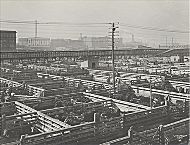Meat packing industry problems
The preparation of beef and pork for human consumption has always been closely tied to livestock raising, technological change, government regulation, and urban market demand. From the Civil War until the 1920s Chicago was the country's largest meatpacking center and the acknowledged headquarters of the industry.
Cattle Pens, Union Stock Yard, c.1920s Europeans brought cattle and hogs to North America, let them forage in the woods, and slaughtered them only as meat was needed. Commercial butchering began when population increased in the towns. Since beef was difficult to preserve, cattle were killed year round and the meat sold and consumed while still fresh. Hogs were killed only in cold weather. Their fat was rendered into lard and their flesh carved into hams, shoulders, and sides, which were covered with salt and packed in wooden barrels. Packers utilized hides, but blood, bones, and entrails usually went into the nearest body of running water. City government, understandably, tried to confine these operations to the outskirts of town.
Europeans brought cattle and hogs to North America, let them forage in the woods, and slaughtered them only as meat was needed. Commercial butchering began when population increased in the towns. Since beef was difficult to preserve, cattle were killed year round and the meat sold and consumed while still fresh. Hogs were killed only in cold weather. Their fat was rendered into lard and their flesh carved into hams, shoulders, and sides, which were covered with salt and packed in wooden barrels. Packers utilized hides, but blood, bones, and entrails usually went into the nearest body of running water. City government, understandably, tried to confine these operations to the outskirts of town.
Americans took their cattle and hogs over the Appalachians after the Revolutionary War, and the volume of livestock in the Ohio River Valley increased rapidly. Cincinnati packers took advantage of this development and shipped barreled pork and lard throughout the valley and down the Mississippi River. They devised better methods to cure pork and used lard components to make soap and candles. By 1840 Cincinnati led all other cities in pork processing and proclaimed itself Porkopolis. Chicago won that title during the Civil War. It was able to do so because most Midwestern farmers also raised livestock, and railroads tied Chicago to its Midwestern hinterland and to the large urban markets on the East Coast. In addition, Union army contracts for processed pork and live cattle supported packinghouses on the branches of the Chicago River and the railroad stockyards which shipped cattle. To alleviate the problem of driving cattle and hogs through city streets, the leading packers and railroads incorporated the Union Stock Yard and Transit Company in 1865 and built an innovative facility south of the city limits. Accessible to all railroads serving Chicago, the huge stockyard received 3 million cattle and hogs in 1870 and 12 million just 20 years later. Stock Yard Canning Room, c.1890 |